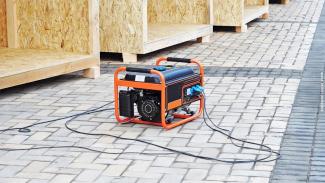Health care facilities commonly use generators to provide primary and backup power. While convenient, they require regular maintenance and access to a reliable fuel supply.
In generator-only systems, the generator must be sized to handle the peak expected load, which means that the system frequently runs at lower loads at reduced efficiency. It is common to find oversized generators in many developing country health facilities, but running an oversized generator is expensive and inefficient and should be avoided.
Cost Considerations
Compared to alternatives, engine generators typically have lower capital costs, but higher operating costs due to the need for fuel. Initial capital costs will be approximately $2,000 for 2.5 kilowatts (kW), depending on the size and type of generator. Operating costs will vary depending on the level of usage. Engines do offer economies of scale in increasing sizes, but utilizing a few smaller units is generally preferred. This allows cycling of the generators for maintenance and the use of one or two units at full load, rather than a larger unit at reduced load. To reduce run time and operation costs, health-care facilities also can add a battery bank to a generator-based system.
Maintenance Considerations
The maintenance considerations for a generator depend on factors such as generator speed, build quality, and frequency of use. Slow-turning generators experience less friction and require less maintenance. High-quality, well-built generators are designed to exert less stress on their components so that they last longer and can operate for longer intervals between major maintenance tasks. Prime power generators, i.e., those rated for continuous running, require more frequent maintenance than standby generators.
Maintenance tasks have to be completed either (1) after a set number of generator run hours or (2) after a set number of days, weeks, months, or years. The most common maintenance tasks include regular visual inspections and coolant and oil level checks and changes. Facility personnel should keep the area in the vicinity of the generator free of any debris that could pose a fire hazard or make access difficult. If the starting battery has liquid battery acid, the acid level also needs to be checked regularly and refilled as necessary. For diesel or petrol generators, the fuel tank and fuel filters also need to be regularly inspected for the presence of water or sediment. Maintenance intervals for mechanical adjustments to engine components, such as the belt, valves, fuel injection nozzles, water pump, engine bearings and seals, and turbocharger, will vary based on frequency of generator use.
Generators are a significant investment for a health facility, and maintenance costs are much cheaper than generator replacement costs. Professional technicians can significantly increase the life of a generator; alternatively, poor maintenance can quickly reduce the life of a generator and necessitate frequent generator replacement. The facility staff member responsible for generator operation should understand how to conduct the daily, weekly, and monthly maintenance requirements of the generator. Facility managers should consider hiring professional technicians to complete semi-annual and annual maintenance tasks as those tasks frequently require specialized training and tools.
Reducing Fuel Costs
- Generators are frequently sized incorrectly at health facilities. It is very inefficient to operate an oversized generator. Replacing an oversized generator is often the most cost-effective intervention to reduce energy costs at a health facility.
- Donor-provided generators are often purchased without consideration for installation fees and maintenance protocols. Poor installation (e.g., using small wires) often leads to poor generator performance (e.g., low voltage at loads) and higher fuel costs.
- Separating critical loads from non-critical loads at larger facilities saves fuel costs by allowing a smaller generator to continuously power a smaller subset of the facility’s regular loads.

© bildlove / Adobe Stock
